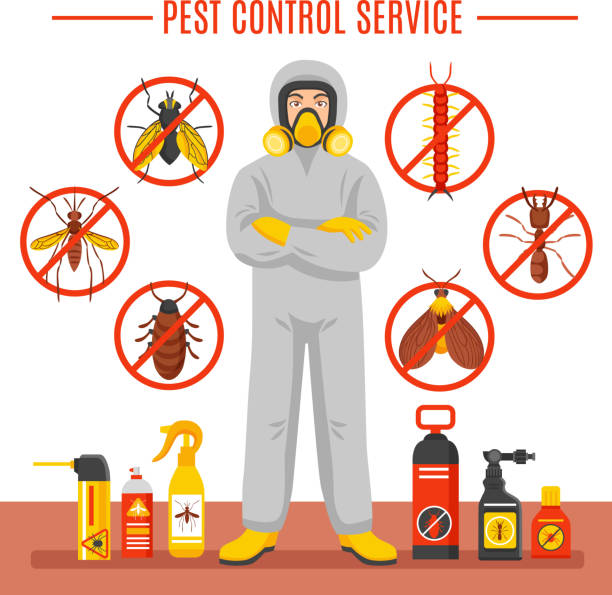Guaranteed Pest Control for a healthier living space.
Cutting-edge Insect Control Techniques for Securing Your Building From Wildlife
As urban locations broaden, the interaction between human habitats and wildlife ends up being progressively complicated, requiring cutting-edge pest control methods to efficiently safeguard residential or commercial property. The effectiveness of these methods is typically contingent on a deeper understanding of wild animals habits and neighborhood participation. This complex strategy increases important questions concerning sustainable coexistence and the long-term effects of our pest control options.
Comprehending Wild Animals Habits
(Pest Management)Recognizing wild animals habits is vital for reliable pest control techniques. By understanding how various varieties interact with their atmosphere, we can establish targeted methods that reduce human-wildlife problems. Animals usually exhibit predictable patterns based upon their requirements for food, sanctuary, and recreation. Identifying these patterns permits insect control experts to prepare for wildlife motions and develop preventive actions.

Additionally, the social frameworks and territorial behaviors of certain types, such as raccoons or deer, can inform control approaches. By utilizing this expertise, bug control can be adapted to be extra humane and effective, promoting coexistence rather than obliteration. Ultimately, a complete understanding of wildlife behavior not only assists in alleviating insect concerns yet likewise cultivates a well balanced partnership between people and nature.
High-Tech Deterrents
The combination of high-tech deterrents into parasite control approaches uses innovative options that build on insights gotten from wildlife actions. These innovative technologies utilize various techniques to produce an atmosphere that is unwelcoming to undesirable bugs while reducing damage to non-target types and the ecological community.
One encouraging technique is the use of motion-activated gadgets that discharge audios or lights. These tools are made to resemble natural killers or create disturbances that discourage wild animals from getting in particular locations. Ultrasonic repellents can disorient pets, making them less most likely to come close to homes or gardens.
In addition, thermal imaging technology enables residential property proprietors to spot pet task before considerable damages occurs. By identifying hotspots of wildlife presence, preventative steps can be carried out purposefully. Another significant development is using smart traps that can alert homeowners when they capture a pet, enabling prompt and gentle elimination.
Furthermore, integrating these high-tech options with existing insect control practices boosts total performance. By using data analytics, homeowner can continuously monitor wild animals interactions and change their strategies accordingly, guaranteeing a positive technique to pest administration that safeguards their properties effectively.

All-natural Repellents
All-natural repellents use a green choice to chemical pesticides, effectively preventing insects while maintaining ecological stability. These materials, stemmed from plants, crucial oils, or other natural resources, can offer a lasting service for handling undesirable wildlife without the negative effects related to artificial chemicals.
(Flea Control)Usual natural repellents include pepper mint oil, citronella, and garlic, each possessing special residential properties that push back specific parasites. For instance, peppermint oil is understood to prevent rodents, while citronella is effective against mosquitoes. In addition, diatomaceous earth, a natural powder made from fossilized algae, can be sprayed around yards to deter crawling pests without harming helpful microorganisms.
The application of natural repellents is simple, commonly calling for straightforward dilution with water for sprays or straight application to influenced areas. Normal reapplication may be required, particularly after rainfall or hefty winds, to preserve efficiency.
Incorporating these natural methods into bug monitoring approaches not only protects residential property however likewise promotes biodiversity, guaranteeing that non-target types are not detrimentally impacted. Pest control service. By picking all-natural repellents, homeowner can attain a balanced technique to pest control that lines up with their environmental worths
Habitat Adjustment
Reliable habitat adjustment serves as an important approach in pest control, dealing with the underlying problems that attract undesirable parasites. By modifying the environment to make it much less congenial to wild animals, residential property proprietors can dramatically reduce the probability of problems. This procedure includes numerous essential practices, including the elimination of possible food sources, water, and shelter that pests may make use of.
One efficient technique is to maintain a tidy landscape, that includes regular lawn upkeep and the removal of debris such as dropped leaves, old timber, and clutter. In addition, making certain that waste is firmly saved in pest-proof containers can hinder rodents and insects from foraging for food.
One more important facet of habitat alteration is the critical placement of plants. Opting for native varieties that are less appealing to parasites can aid keep a balanced environment while minimizing the possibility of undesirable wildlife. Additionally, sealing entry points around the home, such as spaces in doors and windows, prevents this website parasites from locating sanctuary indoors.
Eventually, effective environment alteration not just enhances parasite control efforts but likewise promotes a much healthier atmosphere for both homeowner and local wild animals.
Neighborhood Participation
Neighborhood participation plays a vital function in enhancing the efficiency of insect control initiatives. Involving neighborhood homeowners fosters a feeling of shared obligation, urging individuals to participate proactively in the prevention and monitoring of wildlife-related concerns. When communities work together, they can execute detailed approaches that not only address prompt concerns however likewise establish long-term services.
Curriculum are crucial in this context, as they inform residents about the importance of maintaining clean settings and the influence of human tasks on neighborhood wild animals. Workshops and informative sessions can furnish neighborhood members with important knowledge on best techniques for parasite avoidance, consisting of appropriate waste disposal and habitat modification strategies.
In addition, community-driven efforts, such as community clean-up days or the establishment of wildlife-friendly areas, can dramatically decrease insect populaces. By cultivating open communication and collaboration among homeowners, neighborhood governments, and pest control specialists, neighborhoods can establish tailored strategies that attend to specific local difficulties.
Conclusion
To conclude, carrying out innovative parasite control strategies is essential for effective wildlife monitoring on residential properties. Methods such as utilizing sophisticated deterrents, natural repellents, and environment modification contribute significantly to lessening unwanted animal communications. Cultivating community participation via education and clean-up campaigns boosts the total efficiency of these approaches. By adopting an extensive strategy, homeowner can accomplish an equilibrium in between safeguarding their facilities and advertising ecological harmony.